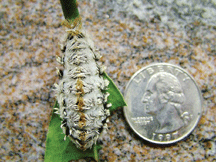
|
Volume 16, Issue 39 - September 25 - October 1, 2008
|

The Healing Powers of the Chesapeake
Over Labor Day, 18 wounded veterans and their families took a break from Walter Reed Army Medical Center to cruise the Bay with sail- and power-boaters of Northern Virginia Sail and Power Squadron. Some made it over to St. Michaels, others up to Annapolis for a cruise around the Naval Academy, still others enjoyed the Rhode and West rivers and their tributaries, and a few toured the lighthouses.
Back on land, the boaters feasted at Chesapeake Yacht Club in Shady Side.
Most had been patients at Walter Reed for about a year; many were looking forward to heading home within the coming months. The average stay at Walter Reed for retuning warriors is eighteen months.
Boat rides have become a favorite recreation of soldiers healing at Walter Reed.
“Since returning home from Iraq over eight months ago, I had not slept at night nor been able to relax in the day,” one soldier reported. “But following that boat ride, I slept my first good night’s sleep and I can relax again.”

Clear-Cutting the Power Path
What do you get when you cross a slasher film with the electric company?
As Bill Burton says, if you know the answer, it’s not a question.
Roadside trees are the common victims of mutilation for the sake of the electricity distribution lines that run above — and between — their branches.
High-voltage transmission lines demand an even closer cut. For them, “BGE maintains 66-foot right of way as part of our maintenance and vegetation-management plan,” explains spokeswoman Rachael Lighty.
That accounts for the periodic clear-cutting beneath BG&E parent-company Constellation Energy’s high lines, which run from Calvert Cliffs Nuclear Power Plant to the Waugh Chapel Road Bulk Transmission Substation, hence to the 13-state Mid-Atlantic power grid. In addition to a five-year clearing cycle, “proactive tree-management activities” are constant, Lightly says.
Weird Neighbors
Smart-cracking Baltimore Circuit Court Judge Charles Bernstein could be your neighbor.
Bernstein made News of the Weird Aug. 14, under the heading Least Competent Corrections Department, for his quote to the Baltimore Sun on July 3. Referring to a convicted drug dealer’s easy escape as he was driven from jail to court in an insecure van, Bernstein said, “If I were a young enterprising criminal, I’d come to Baltimore to set up my practice. This is the place to be. This is the Promised Land.”
The judge keeps a vacation cottage in Port Republic, where he is Chuck and Sandy Erskine’s neighbor.
Smartening up Our Grid
Cheaper electricity could be coming our way. No, Warren Buffett’s not passing along the savings he’s made by buying Constellation Energy, Baltimore Gas and Electric’s parent company at the fire-sale price of $4.7 billion, half what it was worth a week ago.
Our savings is a down-the-road consequence of a grant that gives the Maryland Energy Administration $461,793 to study putting Maryland on a Smart Grid.
That’s a grid smart enough to show us the daily highs and lows of electricity demand, hence prices. Using expensive appliances like dryers and dishwashers when demand is low supposedly can cut utility bills by 15 percent, according to pilot studies.

Up-cycling Your Popped Corks
Annapolis will drink the benefits of recycling by collecting wine corks. The capital city’s corks will be transformed into cork boards sold at Office Max by ‘upcycling’ eco-company TerraCycle.
“Mayor Moyer found an article about a company that’s doing great things with specific items,” says Environmental Program Coordinator Maria Broadbent (410-263-7946 x7788). “We contacted them and said we’ll do a cork collection. This is the first time that they’ve had someone do this on a citywide scale.”
Throw your corks into containers decorated by the Annapolis Senior Center at City Hall, Annabeth’s, Bay Ridge Wine & Spirits, Eastport Liquors, Mills Fine Wine, Scott Brothers and Wine Cellars of Annapolis.
Capital restaurants are also going green with their bottles, collecting corks used at dinner service.
 |
 |
This Week’s Creature Feature
Not everything furry is friendly. Consider the Puss Caterpillar (aka Wooly Slug), a fuzzy insect recently migrated to Maryland from North Carolina. The puss doesn’t bite, but it might as well. The caterpillars inject their venom with barb-tipped fur. The most poisonous caterpillars in the United States, they’re capable of causing intense pain, swelling, rash, fever and symptoms of shock. The contact spot is marked by a stamp pattern.
The caterpillars feed on shade trees, and infestations have been reported in Elkton and in Calvert County. If poisoned by a puss, seek medical attention.
© COPYRIGHT 2008 by New Bay Enterprises, Inc. All rights reserved.